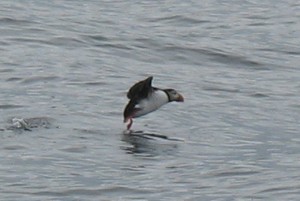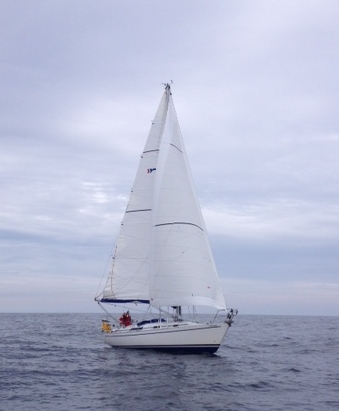Arbroath to Eyemouth – 50.2 miles in 9 hours

A lovely passage today. We started leaving Arbroath as soon as the lock gates opened, but did have to fill up with fuel on the way, so we eventually left the harbour around 07.45. The initial hour or two wasn’t very promising – picking our way through pot markers with around 1 mile of visibility. However, there was a reasonable north easterly breeze and we did manage to start sailing straight away. In fact, though the wind was a little marginal at times, we did manage to maintain an average of over 5 knots and sailed all the way until around 1 hour out of Eyemouth when the breeze finally died. The entrance to Eyemouth is ‘interesting’ and very narrow. For most of the line in (following the leading marks), the harbour entrance isn’t even visible and even once you can see it, it is only 15m wide.
There wasn’t much to see on passage as we were cutting out across the mouth of the Firth of Forth. However, we did go just a couple of miles away from the Bell Rock lighthouse. The Bell Rock is the oldest sea-washed lighthouse and was built by the engineer Robert Stevenson between 1807 and 1810. The masonry on which the main lighthouse sits was so well constructed that it hasn’t been changed or repaired in any way since being built – how times have changed! Bell Rock is a really nasty rock as it lies just below the surface for most of the tide and is several miles offshore. The name apparently stems from an attempt by the Abbott of Arbroath in the 14th Century to install a bell on the rock to warn shipping. It lasted a year before being stolen by some Dutch pirates. In the late 18th century, it was estimated that around six ships each winter were being wrecked on the rocks and the loss of the HMS York and all on board in 1804 finally led to a lighthouse being built. The design is based on the Eddystone light.

The other unmissable thing, though some distance away, was the Bass Rock. The Bass Rock, which is owned by Sir Hew Hamilton-Dalrymple (!), is 350 ft at its highest point and is the world’s largest gannet colony. It is home to more than 150,000 gannets – a very small proportion of which we saw flying in and out around us. The rock was originally home to a Christian hermit, but later a castle was built which became a prison. During the 15th century James I consigned a number of his political enemies there including a number of the Clan MacKay. The prison is even used as a setting in Robert Louis Stevenson’s 1893 book Catriona – the sequel to Kidnapped.
Much of the way across, we were close to a She 36 – Eriska. She left Arbroath around 10-15 minutes before us and for the first hour or so, we didn’t see them because of the poor visibility, but once the mist cleared, we saw her around a mile or so away. From there on we pretty much kept pace for the rest of the passage. Just shy of Eyemouth we slowed down to take some photos of them. They also managed to take a few of us from a distance.
